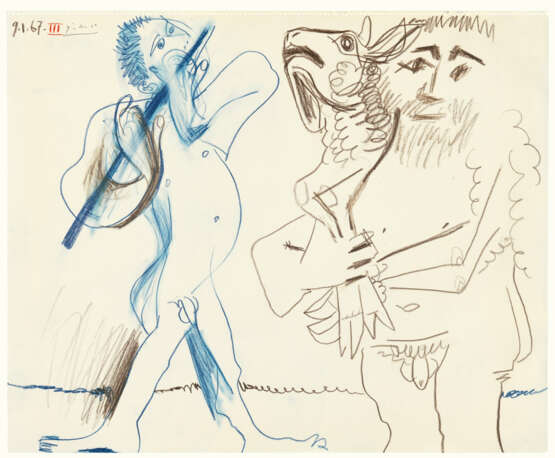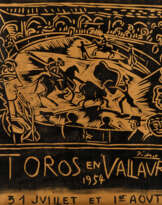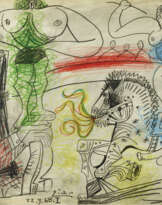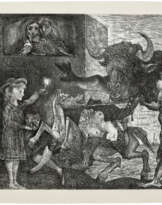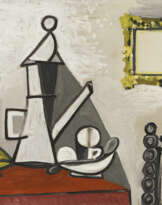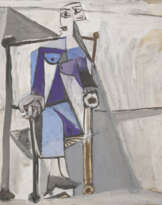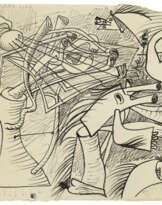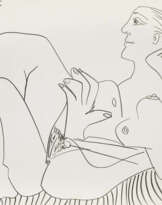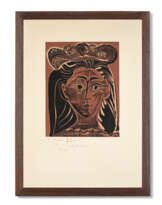ID 832307
Los 123 | Pablo Picasso (1881-1973)
Schätzwert
€ 180 000 – 250 000
Homme à l'agneau et musicien III
signé, daté et numéroté '9.1.67. III Picasso' (en haut à gauche)
crayon gras sur papier
49.5 x 60.7 cm.
Exécuté le 9 janvier 1967
signed, dated and numbered '9.1.67. III Picasso' (upper left)
wax crayon on paper
19 1/2 x 23 7/8 in.
Executed on 9 January 1967
Provenance
Lionel Prejger, Paris.
Collection particulière, Italie (acquis auprès de celui-ci); vente, Christie's, Londres, 26 juin 2003, lot 430.
Haaken Christensen, Oslo (acquis au cours de cette vente).
Collection particulière, Oslo (par descendance); vente, Sotheby's, Londres, 26 juin 2008, lot 139.
Collection particulière (acquis au cours de cette vente); vente, Christie's, Londres, 21 juin 2012, lot 113.
Dr. Walid Juffali, Londres (acquis au cours de cette vente).
Vente, Bonhams, Londres, 1er mars 2018, lot 19.
Acquis au cours de cette vente par le propriétaire actuel.
Literature
R. Char et C. Feld, Picasso, His Recent Drawings, 1966-1968, New York, 1969, p. 251, no. 74 (illustré, pl. 74).
C. Zervos, Pablo Picasso, Œuvres de 1967 et 1968, Paris, 1973, vol. 27, no. 421 (illustré, pl. 176).
Exhibited
Oslo, Galleri Haaken, Picasso, Maleri, Skulptur, Tegning, septembre-octobre 2004 (illustré).
Special Notice
Artist's Resale Right ("droit de Suite").
If the Artist's Resale Right Regulations 2006 apply to this lot, the buyer also agrees to pay us an amount equal to the resale royalty provided for in those Regulations, and we undertake to the buyer to pay such amount to the artist's collection agent.
ƒ: In addition to the regular Buyer’s premium, a commission of 5.5%
inclusive of VAT of the hammer price will be charged to the buyer.
It will be refunded to the Buyer upon proof of export of the lot
outside the European Union within the legal time limit.
(Please refer to section VAT refunds)
Post Lot Text
Début 1967, les dessins de Pablo Picasso se trouvent momentanément dominés par la figure d'un homme tenant dans ses bras un agneau, représenté auprès d'un musicien. L'artiste explore différentes interprétations de ce thème dans une suite d'images dont celle-ci, réalisée le 9 janvier 1967, est la troisième variation à voir le jour. Le surlendemain, il en signe une autre version aux crayons de couleur, dans un dessin très vif qui réside aujourd'hui à l'Art Institute of Chicago. Homme à l'agneau et musicien donne à voir la puissance extraordinaire du tracé de Picasso, parfois plus impressionnant encore pour ce qu'il omet que pour ce qu'il énonce. En témoignent, sur la droite de la feuille, la partie latérale du visage du protagoniste ainsi que le dos du mouton, dont on déduit la présence plus qu'on ne la perçoit grâce aux vagues indications du crayon. En même temps, la figure du musicien est rendue par des traits bleus souples et spontanés que l'artiste a volontairement étalés ou estompés par endroits, lui conférant une allure mystérieuse, éthérée. La tête de l'agneau, quant à elle, est traitée d'une manière qui rappelle les crânes d'animaux que Picasso avait glissés dans ses natures mortes quelques années plus tôt. Dans l'ensemble, tout sentiment de malaise est néanmoins banni par la gaieté sautillante du joueur de flûte, et le regard serein du noble berger qui veille sur son troupeau.
Pendant les années 1960, l'imagerie de Picasso prend volontiers des airs fantasques, enchantés, à l'instar de cette scène pastorale très bucolique. Homme à l'agneau et musicien respire la douceur de vivre, les délices d'une existence faite de musique et de nature, de valeurs simples. En même temps, la scène nous plonge dans l'univers plus classique de Picasso, peuplé de faunes et de satires, et empreint de mythologie, de magie, de poésie. Muni de sa flûte, le musicien semble notamment procéder du monde des bacchanales ou des fêtes dionysiaques.
Le motif de l'homme à l'ovin a longtemps fasciné Picasso. Il en a d'ailleurs fait le sujet d'une de ses sculptures les plus célèbres, Homme au mouton, dont un bronze est conservé au Musée Picasso de Paris et un autre au Philadelphia Museum of Art. Conçue sous l'Occupation en symbole d'espoir et de dignité humaine, cette figure puise dans l'iconographie chrétienne du Bon Pasteur autant qu'elle s'inspire d'une œuvre actuellement abritée par le musée de l'Acropole d'Athènes, le Moschophore, statue antique du VIe siècle av. J.-C représentant un homme portant un veau. Si Picasso se tourne en 1967 vers ce thème qu'il avait déjà abordé dans sa sculpture, c'est peut-être en partie grâce à Roland Penrose, lequel monte une importante rétrospective de l'artiste cette année-là. D'abord présentée à la Tate de Londres puis au Museum of Modern Art de New York, l'exposition présente entre autres des sculptures jusqu'alors jalousement conservées dans la collection personnelle de Picasso, révélant ainsi au public un pan inédit de son œuvre. C'est également en 1967 que la sculpture monumentale de l'Espagnol, Tête, est inaugurée au centre de Chicago.
En termes de provenance, la destinée d'Homme à l'agneau et musicien est également liée à la sculpture. C'est au début des années 1960 que Picasso se rapproche pour la première fois de Lionel Prejger, l'ancien propriétaire de ce dessin. Directeur d'une usine de métaux, Prejger se voit bientôt confier la délicate tâche de transposer à l'acier les sculptures en papiers pliés et découpés de l'artiste. Grand amateur d'art, Prejger assemblera au fil des années une importante collection constituée, entre autres, d'œuvres de Pierre Bonnard, Fernand Léger, Henri Matisse, Édouard Vuillard, et d'un grand nombre de travaux de Picasso.
During the beginning of 1967, the theme of a man holding a sheep shown alongside a musician dominated Pablo Picasso's drawings. In a string of images, Picasso explored variations upon the theme. Indeed, Homme à l'agneau et musicien was the third that he created on 9 January 1967. Two days later, he would draw another example using a range of coloured crayons, a work that is now in the Art Institute of Chicago. Homme à l'agneau et musicien reveals Picasso's incredible strength of line, sometimes more impressive by its omissions than by its inclusions, as is the case with the man holding the sheep: the side of his head and indeed much of the back of the sheep are inferred rather than seen, as the viewer is prompted by Picasso's cues. Meanwhile, the figure of the musician is rendered using sweeping blue lines which have in parts been deliberately smudged, lending him an ethereal and otherworldly air. The head of the lamb has been captured in a way that recalls Picasso's earlier still life compositions showing animal skulls; yet overall, any sense of foreboding is banished by the prancing jollity of the musician and the serene gaze of the noble shepherd who is tending to his flock.
During the 1960s, Picasso's pictures often took a whimsical turn, as is the case in Homme à l'agneau et musicien, which shows a bucolic idyll. There is a sense of the charmed life, of music and nature, of the simple values of life. At the same time, the viewer is plunged into the classical world of Picasso's satyrs and fauns, a realm of mythology, magic and poetry. With his flute, the musician appears to be a part of a Bacchanal, an orgiastic celebration.
The theme of the man holding a sheep was one that had long captivated Picasso. Indeed, it had been the subject of one of his most celebrated sculptures, the Homme au mouton, a cast of which is held by the Musée Picasso, Paris and another in the Philadelphia Museum of Art. Created during the Occupation, this had been a symbol of hope and human dignity, tapping into the Christian iconography of the Good Shepherd as well as the more ancient Greek moscophoros, the sculpture of a man carrying a calf, a celebrated example of which dates from the Sixth Century BC and is in the Acropolis Museum, Athens. That Picasso was turning towards the theme of one of his own earlier sculptures may have related to the fact that it was during the course of 1967 that Roland Penrose finished the organisation of an exhibition dedicated to the artist's plastic works. Shown first in the Tate, London and then in the Museum of Modern Art, New York, the exhibition focused on the sculptures that remained in Picasso's own collection and thus revealed a new side to the artist. It was also in 1967 that Picasso's monumental sculpture, Tête, was unveiled in Chicago.
This sculptural theme extends to the provenance of Homme à l'agneau et musicien, which was formerly owned by Lionel Prejger. In the early 1960s, Picasso had come into contact with Prejger and came to collaborate with him, using his metal factory in Vallauris to immortalise the sculptures that he had made of cut and folded sheets of paper by transferring the designs into steel. Prejger came to assemble an impressive collection comprising works by artists such as Pierre Bonnard, Fernand Léger, Henri Matisse, Edouard Vuillard and a significant number by Picasso.
| Künstler: | Pablo Picasso (1881 - 1973) |
|---|---|
| Angewandte Technik: | Malstift |
| Material: | Acrylglas, Kunststoff |
| Künstler: | Pablo Picasso (1881 - 1973) |
|---|---|
| Angewandte Technik: | Malstift |
| Material: | Acrylglas, Kunststoff |
| Adresse der Versteigerung |
CHRISTIE'S 9 Avenue Matignon 75008 Paris Frankreich | ||||||||||||||
|---|---|---|---|---|---|---|---|---|---|---|---|---|---|---|---|
| Vorschau |
| ||||||||||||||
| Telefon | +33 (0)1 40 76 85 85 | ||||||||||||||
| Fax | +33 (0)1 40 76 85 86 | ||||||||||||||
| Nutzungsbedingungen | Nutzungsbedingungen | ||||||||||||||
| Versand |
Postdienst Kurierdienst Selbstabholung | ||||||||||||||
| Zahlungsarten |
Banküberweisung | ||||||||||||||
| Geschäftszeiten | Geschäftszeiten
|

